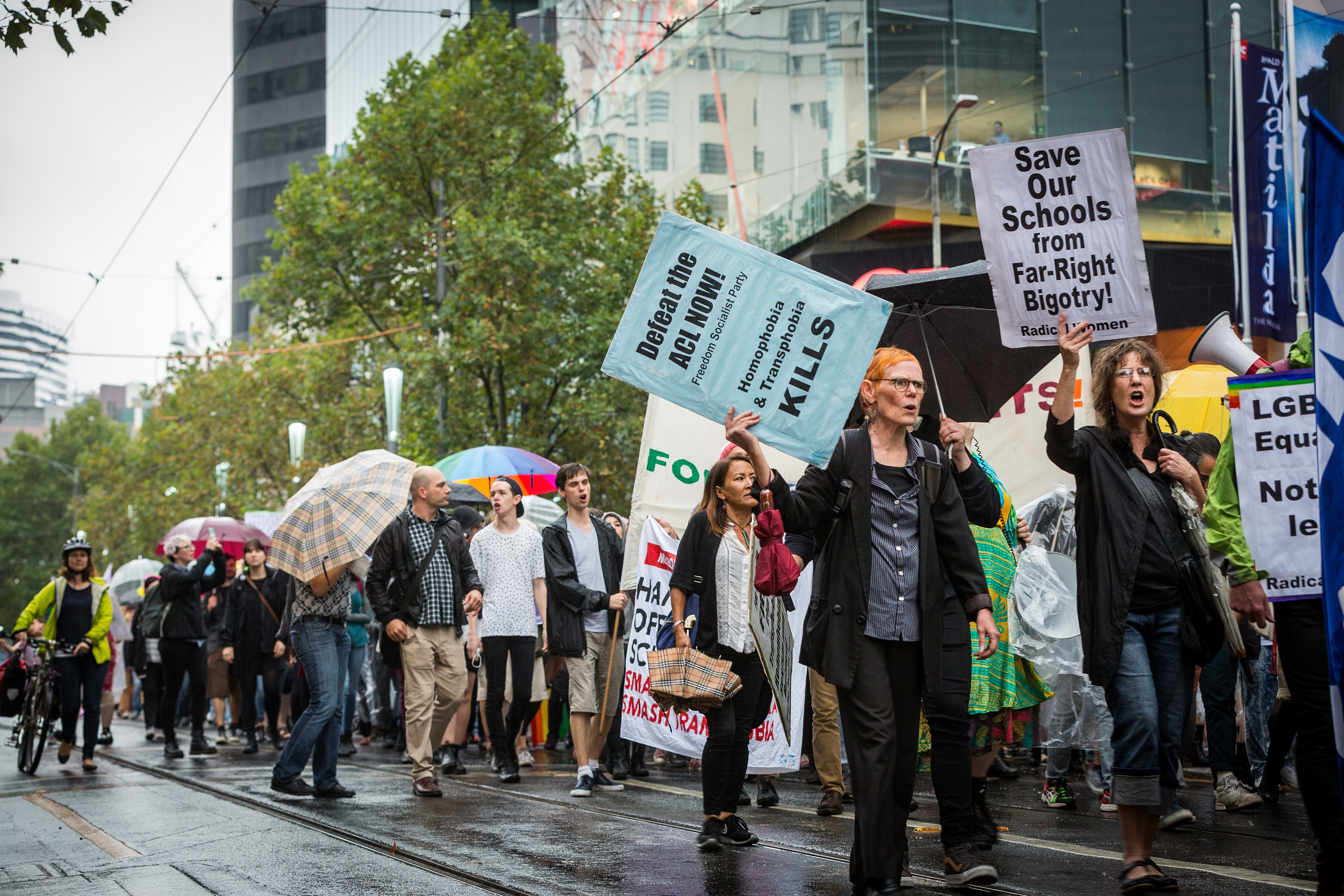A day after the November election, a teacher at a Michigan junior high school noticed two students lying on the ground before class. When asked what they are doing, they said they were forming a wall, as a joke. Later the same day, a larger group of students at the same school locked arms and prevented other students from passing in the hallway. “Let’s build a Wall,” they shouted, telling one Latina student she should go back to Mexico. Closer to home, anti-Semitic incidents at a school in Amherst, Mass. prompted the principal to schedule assemblies to address bullying, harassment, and anti-Semitism and, for a week, students engaged in a curriculum about the history of anti-Semitism.
These incidents illustrate the dangerous effects of hate being modeled and reinforced on a national stage, according to a team of UConn school climate and behavior experts. Now spilling into classrooms and schools across the nation, these developments are presenting educators, parents, and communities with significant, immediate challenges as they seek to support students, while faced with their own feelings of stress, confusion, and lack of preparedness.
The support being offered in the media focuses largely on how to respond when such an incident occurs, but a positive, proactive approach has been proven to be a far more effective strategy, says one of the experts, associate professor Brandi Simonsen. She and fellow faculty members George Sugai, Jennifer Freeman, and Tamika LaSalle at UConn’s Behavioral Education and Research Center in the Neag School of Education recently authored a paper outlining empirically supported, high-impact practices that school leaders and educators must employ now to bolster school climates before incidents occur. Over 23,000 schools across the country have already implemented Positive Behavior Interventions and Support (PBIS) practices, says Simonsen, who is co-coordinator of the Northeast PBIS Network and a partner in the PBIS National Technical Assistance Center run by UConn, the University of Oregon, and the University of Missouri. In this interview with UConn Today, she explains why there should be more.
Q. What is the current climate you are seeing in public schools around bullying and hate messages?
A.We don’t have clear and reliable national data to describe the number of incidents truly happening in schools, but we are hearing many anecdotal stories. For example, we’re seeing news media and social media reports of hate speech being written as vandalism in schools, we’re hearing about hate speech being used from student to student.
In addition to that, we are hearing reports – and again, we don’t have great national data to say how often or how many – about some students experiencing increases in anxiety or worry about the national scene. Kids are worried about deportation; students from lesbian, gay, bisexual, and transgender families are worried about their family composition and what’s going to happen to them; and kids in different racial and cultural groups are concerned about how they are being treated and how they will be treated.
So we’re seeing these sorts of flare-ups of hate, and we’re also seeing these reactions of fear from students. Students say they are arriving at school anxious, upset, scared, stressed, or angry. While some students will successfully and productively move through their day, others display signs of withdrawal, anxiety, depression, or other mental health concerns. In addition, students may bring hurtful speech and actions into school, be on the receiving end of hurtful conduct, or be bystanders witnessing such disrespectful behavior.
Q. Have you seen an increase in these incidents in schools over time?
A.Incident reporting does seem to be increasing; however, we don’t know for sure whether the increases in incident reporting is caused by election results, heightened media exposure of specific incidents, increased reporting of incidents that have not been reported in the past, etc. Regardless of the prevalence rates, we have an obligation to be prepared to respond to and prevent future incidents of inappropriate behavior and victimization, which are unlikely to be totally eliminated. Although we can never prevent all possible types of events, doing nothing runs the risk of us being unprepared and sitting on our hands if students, teachers, and/or family members experience a serious incident.
Q. What prompted you and your colleagues to call for action now?
A.We’re worried that the recent stories could be the beginning of a more significant increase in these behaviors. We also know that schools often serve as the de-facto mental health support system for students. Providing all students with a safe, predictable, and positive environment is critical in effectively addressing many mental health concerns. Basic positive and proactive practices work. When these key practices are implemented well, students’ social and emotional, behavioral, and academic outcomes improve. By implementing positive, proactive practices, schools can effectively support students who may experience greater difficulties and require additional support.
Q. What has been the general response so far at schools?
A.Most of the responses I see coming out in the media are just that – they’re focused on how to respond to bullying or other negative behaviors. In other words, they are reactive – waiting for the problem to show up, and then giving schools, families, or community members strategies to react. Traditionally, when schools react to problems, they resort to zero tolerance policies and different punishment strategies to try and decrease the problems. Those responses are typical and they have happened for decades. But the problem is that they miss the opportunity to be proactive and positive, and they may have negative, unintended consequences.
Q. What responses to bullying and hate speech work and don’t work?
A. As we look at the national landscape, schools have access to a really clear, systematic, and empirically validated approach to address problems like this. And so, rather than waiting for a problem to show up, we advocate that now is the time for schools to make sure a positive and proactive approach is applied across all students, staff, and sub-groups in the building, so that all kids both behave respectfully toward others and are respected by other students and by staff.
In classrooms and schools, there is clear evidence that when teachers implement positive and proactive practices, students benefit academically and socially. There is also clear evidence that in the absence of these practices, students engage in more disruptive behavior, which decreases teachers’ ability to teach. Disruptive behavior affects both the classroom process and academic outcomes, because teachers are losing instructional minutes to manage behavior. For individual students with more intense behavioral issues, these outcomes are magnified; kids who struggle with behavior experience the most reactive management and the least positive and proactive support, so it’s not surprising that they have some of the worst outcomes.
Q. Can you highlight the best practices that school leaders and educators can employ to head off bullying and hate speech?
A.Establish positively stated expectations that explicitly communicate respect for all students, and that value and embrace diversity among students as well as adults.
Clearly describe how students and adults can display observable expectations in each classroom routine and school setting that contribute to a common language and a predictable, respectful, and safe experience for all.
Explicitly and purposefully teach expectations across all classroom routines and school settings. Specifically define, model, and practice each expectation, and use positive and negative examples so that students see the line between appropriate and inappropriate behavior and actions. Also, teach students specific problem-solving strategies for instances in which they experience or see disrespectful behavior. Create a school-wide “stop signal” for disrespect, and teach students to use that signal to walk away from disrespectful acts.
Use data to monitor implementation, and screen for students who require more intensive support. Monitor how lessons are provided and how students respond to the behavior of their peers. Utilize school climate data to examine the experiences of groups of students who may be more personally affected by the national conversation, including students who identify as Muslim, Jewish, Black, Latino, or LGBTQ; have disabilities, a history of trauma, or mental health challenges; or represent other diverse backgrounds. Diversity is a positive quality; embracing and valuing diversity requires a safe, respectful environment, and a deliberate approach that supports all students, families, and staff members.
Q. Do educators play a role in reducing bullying not just within the walls of the school but beyond?
A.Educators, like any citizen, have a role within and outside the classroom to (a) model effective, prosocial behaviors that prevent occurrences and escalations of inappropriate behavior; (b) be an effective bystander by supporting victims or potential victims of inappropriate acts; (c) voicing opposition to hateful behavior; (d) encouraging students to be effective bystanders who support individuals who are being victimized; and (d) reinforcing and recognizing other individuals who display heroic non-discriminatory behavior and acts. Educators have a responsibility to inform family members about the prosocial skills that are being encouraged at school to maintain safe and respectful learning environments and reduce the likelihood of inappropriate behavior and acts.
Q. What role do parents and the community play?
A.I think many of the strategies we talk about in school make sense in families and communities. Parents and community leaders can communicate clear expectations and actively teach how to be respectful and kind to all others. They can draw on local examples from their families and communities, and they can identify what to do if someone is not respectful and kind. For example, my son is in kindergarten and my daughter is in preschool. We have this conversation regularly at our dinner table: We talk about how to be kind to others, and we also discuss what steps they can take if someone isn’t kind to them. Hopefully, that’s also happening at their schools, but it’s important that we talk about it at home to reinforce what they are learning, teach them to be kind, and help them be successful if something does come their way.



